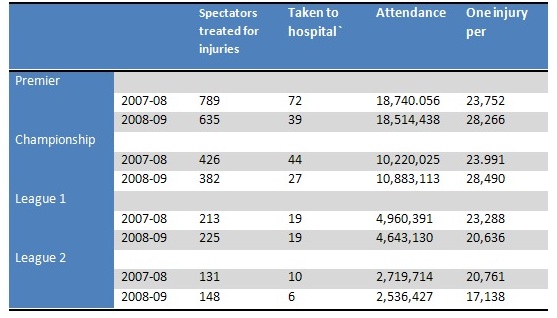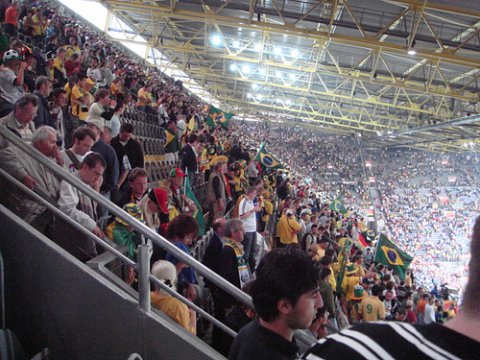Making a stand for standing
With an election imminent, Labour has made a pitch for the football supporters’ vote.
Its manifesto will include proposals to force clubs to hand over 25 per cent stakes to supporters’ groups, and give them the right to bid first when a club comes up for sale. Or so The Guardian reported on Monday.
These ideas are unlikely to amount to anything. But had Labour been on its toes, it could have offered supporters something that many of them would dearly like – the right to watch the game standing up, at least in part of the ground. That would be far easier to implement than amendments to company law which would be needed to bring about the changes to be promised in the manifesto.
The Football Supporters' Federation has long campaigned for the right to stand, but has temporarily ceased the struggle while awaiting the election result. It looks as if it might have missed a trick.
Ever since the Hillsborough disaster of 1989 and the Taylor Report that followed it, there has been an argument between traditional supporters, who enjoyed standing on the terraces, and the Football Licensing Authority. Much turns on the value of the statistics produced by the FLA on the number of injuries to spectators.
Teams in the Premiership and Championship are required to accommodate all their fans on seats, and those who insist on standing up can be ejected from the ground. Whilst many fans would like a choice between standing and sitting, the Government argues this is unsafe, citing the FLA statistics in support.
The Taylor Report itself stated that standing was “not intrinsically unsafe” and in 1995, Tony Blair, the then leader of the opposition, said “I was never convinced . . . that the removal of all standing was necessary . . . While safety must always be the ultimate criterion, there is no reason to ignore technological improvements made since Taylor reported, which might allow for safe standing.”
A survey by the Football Fan’s Census (FFC) in 2007 found that of 2,046 fans who responded, 92 per cent would like the choice to sit or stand. This was quoted in a 2007 report by the Football Supporters’ Federation backing safe standing, but rejected by Gerry Sutcliffe, the Minister for Sport, based on the FLA’s statistics.
The FSF didn’t, however, take this sitting down. Together with the pressure group Stand Up Sit Down, it produced a report in January 2009 highlighting what it said were failings in the FLA figures that Sutcliffe quoted. Errors or inaccuracies were found in figures for attendances, number of injuries sustained and areas in the ground where injuries occurred.
The numbers of injuries per spectator were said to be distorted in favour of the Premiership as a result of including crowds at overseas games. In addition, multiple errors both in the attendance figures provided to the FLA by football clubs and the transcription of the figures were noted. Injury figures from grounds were not split into those sustained in seated areas and those sustained in standing areas and in some cases injuries caused outside the stadium itself were not differentiated from those inside.
The FSF concluded by saying: “Until they produce some proper evidence, the FLA and DCMS [Department for Culture, Media and Sport] should stop using the injury statistic numbers to support their claim that all-seated stadia are safer than grounds with standing areas.”
The FLA responded by saying that Government policy is neither underpinned by the FLA’s analyses nor based solely on safety concerns. Crowd management and distribution is also important. However, safe standing supporters say that this is easily dealt with by allocating a specific seated/standing area to each ticket as is done at many German grounds (constantly pointed to as examples of successful safe standing).
As for the Government not relying on FLA statistics, nobody seems to have told Gerry Sutcliffe. His letter to the FSF draws extensively upon the injury statistics provided by the FLA and draws conclusions from them, according to Malcolm Clarke, the Chair of the FSF. He wrote to the UK Statistics Authority asking them to adjudicate, but as the injury statistics are not official statistics, they could not do so.
The latest figures (below) were published by the FLA in January and covering the 2008-09 season They continue to show a greater rate of injuries at grounds where sitting is not compulsory but the FLA's analysis of the figures has changed.

While in 2005-06 the FLA speculated that higher injury rates at League 1 and 2 grounds could be related to standing, they do not make such a claim this time. “We have been unable to establish any clear link between the type of accommodation and the number of reported injuries” the FLA says. This is in spite of the fact that while injury rates have improved in the top two divisions, they have worsened in the lower two. Of this, the FLA says: “There was no obvious pattern or any evident safety factors to explain the changes in the figures.”
At present it seems that either Government policy is supported by the FLA’s statistics (as the Minister for Sport suggests) or it isn’t (as the Chair of the FLA suggests). If the seating-only policy is based on the FLA’s injury analysis then the statistical issues highlighted by the FSF undermine its force. If it is not based on FLA data then, in terms of safety, what is it based on?
Backing for the safe standing campaign is widespread. In the summer of 2008 the Liberal Democrats formally announced their support and SUSD maintain an active website and have amassed over 13,000 signatures on a petition to review the issue.
Supporters say that safe standing improves the atmosphere, would enable lower ticket prices and a better viewing experience for both those who choose to sit and those who choose to stand. Even at all-seater grounds, spectators spend a good deal of time standing up when play becomes exciting (as in the picture below) leaving those behind them little choice but to do the same. Some even stand on seats, which even the most enthusiastic supporter of seating would hardly recommend. German grounds in the Bundesliga serve as models for success for standing, with sections set aside for spectators who prefer it, superb atmospheres, low ticket prices and safe environments.

Restoring standing, or even promising to look at it again, would have been a more persuasive argument for many supporters than what Labour actually plans. It would have been credible, which the present promises aren’t. And, judging by the German experience, it would have been practicable, too.



